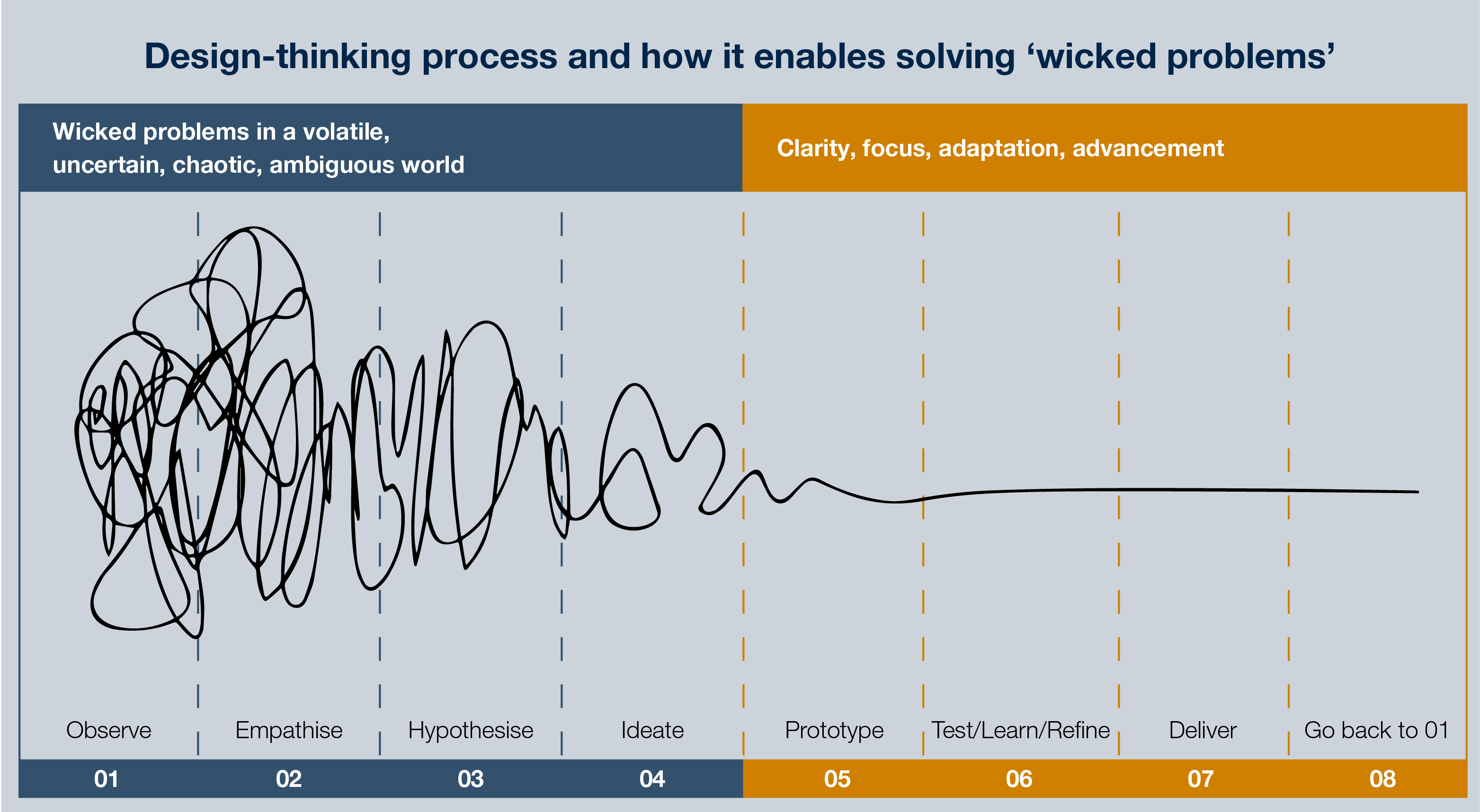Design for Good: Using Design Thinking to Drive Innovation and Accelerate Systemic, Transformational Change in Healthcare
From managing staff burnout to clearing patient backlogs and using technology to advance care, the challenges facing healthcare leaders in the post-pandemic world are difficult, complex and seemingly intractable.
They can also be best defined as “wicked,” a term coined by design theorists in the 1970s to capture problems with many complex interdependent factors that seem impossible to solve. Healthcare issues are indeed multifaceted and interconnected by nature, involving different stakeholders with conflicting values and priorities. They are also difficult to define, ambiguous, and do not have one single solution.
The combination of innovative human-centred approaches and technology offers ways to answer the questions posed by wicked problems. Design thinking in particular, with its range of multidisciplinary, team-based, agile and iterative processes, has become an important tool in organisations’ efforts to transform healthcare.
Some of the typical healthcare challenges that creative design thinking can help solve include:
- Driving digital transformation to enable rapid innovation and new care model proposition creation
- Combating workforce burnout and re-designing the workforce experience
- Reducing elective care waiting list while improving service delivery
- Identifying new opportunities to drive efficiency, effectiveness and create value
A&M practitioners have worked on a range of projects that used design thinking techniques to deliver systemic, transformational change for large corporations, health-tech start-ups, non-profits and the public sector. Our unique proposition combines the firm’s legacy of operational excellence and leadership-led stakeholder engagement and alignment, with proven expertise in designing and delivering intelligent health journeys and digital-enabled operating models.
Design thinking (and doing) in action
Design thinking is uniquely positioned to help healthcare leaders because it puts the human perspective at all stages of the problem-solving process, taking patient, carer and staff’s experiences, needs, capabilities and expectations into account. It enables organisations to see how they can (re)engineer their processes, skills, incentive models and systems to deliver better experiences and more value to users, the organisation and the broader stakeholder ecosystem.
The application of design techniques alongside expert input means that impactful results can be realised in weeks rather than months, in a resource-light manner. This acceleration is critical in today’s uncertain and technology-driven environment where the needs, constraints and desires of users are evolving at fast pace.

But how is that achieved in practice? One of the many methods utilised in design thinking is the creation of service blueprints that map out online and offline touchpoints in each user’s clinical pathway, enabling the identification of pain and gain points. These visual blueprints identify the complete set of technology, workflow, role, skill, incentive and cultural changes necessary to implement new processes of care and sustain their adoption at scale.
This is often created through collaborative workshops with patients, medical staff, managers, designers and technologists, as well as experts providing orthogonal perspectives from related industries. Stakeholders are also invited to objectively “sense check” and test the solutions before implementation, identifying broader constraints in the ecosystem, such as regulations, resources or incentives, which need to be addressed for the innovation to scale and sustain.
These design sprint exercises can select the most impactful, scalable and viable ideas, saving development time and money. If well used, this capability can help clients strategically re-cast their initiatives, offerings and business models, setting them for future sustainable growth.
The value of design thinking for organisations
Recent experiences show how the combination of interdisciplinary expertise, agility and rigorous validation offered by design thinking can not only improve the experience of professionals and patients but also create value for businesses and society as a whole.
The work of the Behavioural Insights Team, set by the UK government in 2010 to apply behavioural science in solving big social challenges, played a relevant role in encouraging people to come forward for Covid-19 vaccinations. The NHS has also effectively adopted agile practices during the pandemic for delivering the vaccine, with ‘Covid-Light’ sites being set up in hospitals and other locations.
The economic impact of design thinking in corporations has also been proven in recent studies. Research conducted in 2018 found that user-centric, design-led companies tend to deliver higher revenue growth and return to shareholders compared to their industry counterparts. Another investigation in 2019 showed that the method significantly reduces the time spent in design and development stages.
Why design thinking advances digital transformation
Leveraging technology is critical in delivering the systemic change needed to address wicked problems in healthcare. As everyone understands, digital transformation should not be about implementing the latest technology, in a plug-and-play approach that ignores the unique needs of the organisations, users and ecosystem stakeholders.
Successful digital transformation can only be achieved through a multidisciplinary effort that puts people and the stakeholder ecosystem at the centre of the solution. Design thinking has the potential to be a game-changer for healthcare organisations because it offers the tools and methods to achieve precisely that.
- In human-centric design, products and services are thought through from the perspective of the user and broader stakeholders, putting their real needs at the heart of idea generation, solution development and implementation.
- The different stakeholders collaboratively “play a problem” to explore its various aspects, anticipate constraints and design different solutions to these constraints.
- Having played a role in designing a product and service, stakeholders’ engagement in and commitment to implementation is higher as they become ‘owners’ of the solution.
- The method relies heavily on prototype and stress-testing, enabling easy adjustments during the development, minimising implementation risk and allowing more commercially viable products to emerge.
- Critically, stress-testing and adjustments also focus on the wider organisational and ecosystem factors that are critical to sustainable adoption and commercialisation of the innovation at scale, including culture, organisation, skills and incentive models.
If you are interested in these ideas and want to know how they can impact your organisation, please contact David Champeaux at dchampeaux@alvarezandmarsal.com, Alex Barclay at abarclay@alvarezandmarsal.com, Jean-Laurent Poitou at jlpoitou@alvarezandmarsal.com and Raymond Berglund at rberglund@alvarezandmarsal.com.
[2] https://www.forrester.com/blogs/design-thinking-can-deliver-an-roi-of-85-or-greater/
A&M: Leadership. Action. Results
A&M’s Healthcare & Life Sciences team brings decades of experience and fact-based, action-oriented leadership to create value and drive rapid results for health care businesses. We offer a “bias-to-action” approach through world-class advisory experience to address mission-critical objectives and dramatically improve top and bottom-line results across the pharmaceutical, medical device, health tech, and healthcare service industries.




